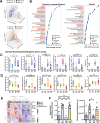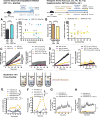The Gut Microbiota Mediates the Anti-Seizure Effects of the Ketogenic Diet
- PMID: 29804833
- PMCID: PMC6003870
- DOI: 10.1016/j.cell.2018.04.027
The Gut Microbiota Mediates the Anti-Seizure Effects of the Ketogenic Diet
Erratum in
-
The Gut Microbiota Mediates the Anti-Seizure Effects of the Ketogenic Diet.Cell. 2018 Jul 12;174(2):497. doi: 10.1016/j.cell.2018.06.051. Cell. 2018. PMID: 30007420 Free PMC article. No abstract available.
Abstract
The ketogenic diet (KD) is used to treat refractory epilepsy, but the mechanisms underlying its neuroprotective effects remain unclear. Here, we show that the gut microbiota is altered by the KD and required for protection against acute electrically induced seizures and spontaneous tonic-clonic seizures in two mouse models. Mice treated with antibiotics or reared germ free are resistant to KD-mediated seizure protection. Enrichment of, and gnotobiotic co-colonization with, KD-associated Akkermansia and Parabacteroides restores seizure protection. Moreover, transplantation of the KD gut microbiota and treatment with Akkermansia and Parabacteroides each confer seizure protection to mice fed a control diet. Alterations in colonic lumenal, serum, and hippocampal metabolomic profiles correlate with seizure protection, including reductions in systemic gamma-glutamylated amino acids and elevated hippocampal GABA/glutamate levels. Bacterial cross-feeding decreases gamma-glutamyltranspeptidase activity, and inhibiting gamma-glutamylation promotes seizure protection in vivo. Overall, this study reveals that the gut microbiota modulates host metabolism and seizure susceptibility in mice.
Keywords: 6-Hz seizures; Akkermansia; GGsTop; Kcna1; Parabacteroides; epilepsy; gamma-glutamyl transpeptidase; ketogenic diet; microbiome; microbiota.
Copyright © 2018 Elsevier Inc. All rights reserved.
Conflict of interest statement
The authors declare no competing interests. Findings reported in the manuscript are the subject of UCLA provisional patent application US 2017/67548.
Figures







Comment in
-
A Gut Feeling About Seizures.Epilepsy Curr. 2018 Nov-Dec;18(6):389-390. doi: 10.5698/1535-7597.18.6.389. Epilepsy Curr. 2018. PMID: 30568557 Free PMC article. No abstract available.
References
-
- Baraban SC, Southwell DG, Estrada RC, Jones DL, Sebe JY, Alfaro-Cervello C, Garcia-Verdugo JM, Rubenstein JL, Alvarez-Buylla A. Reduction of seizures by transplantation of cortical GABAergic interneuron precursors into Kv1.1 mutant mice. Proceedings of the National Academy of Sciences of the United States of America. 2009;106:15472–15477. - PMC - PubMed
-
- Barton ME, Klein BD, Wolf HH, White HS. Pharmacological characterization of the 6 Hz psychomotor seizure model of partial epilepsy. Epilepsy research. 2001;47:217–227. - PubMed
-
- Beloosesky Y, Grosman B, Marmelstein V, Grinblat J. Convulsions induced by metronidazole treatment for Clostridium difficile-associated disease in chronic renal failure. The American journal of the medical sciences. 2000;319:338–339. - PubMed
-
- Bough KJ, Rho JM. Anticonvulsant mechanisms of the ketogenic diet. Epilepsia. 2007;48:43–58. - PubMed
Publication types
MeSH terms
Substances
Grants and funding
LinkOut - more resources
Full Text Sources
Other Literature Sources
Medical
Molecular Biology Databases

